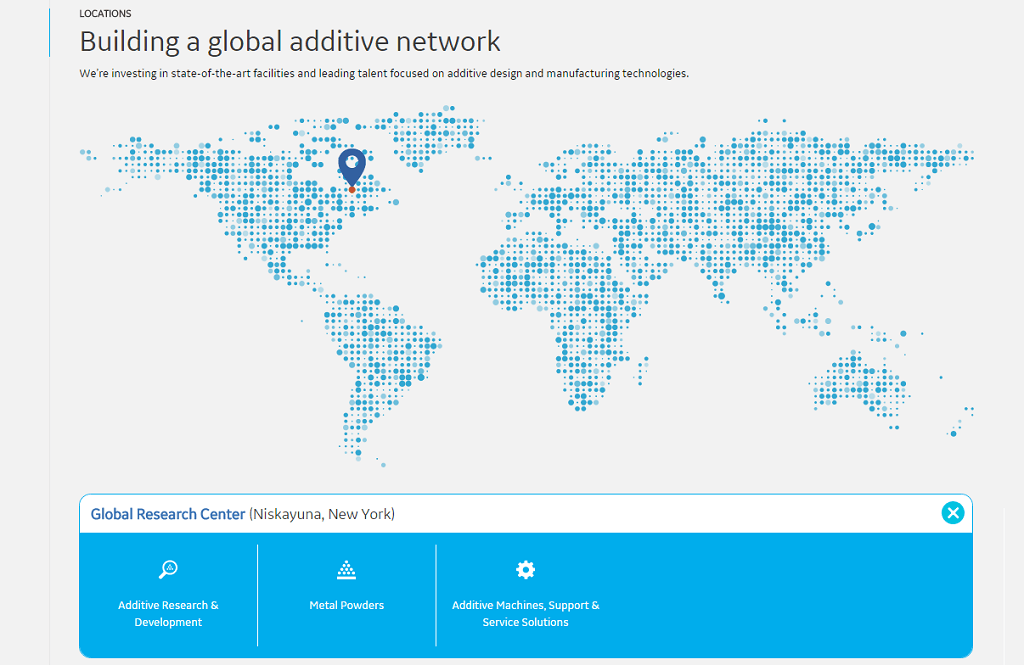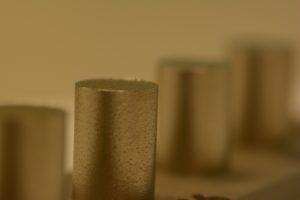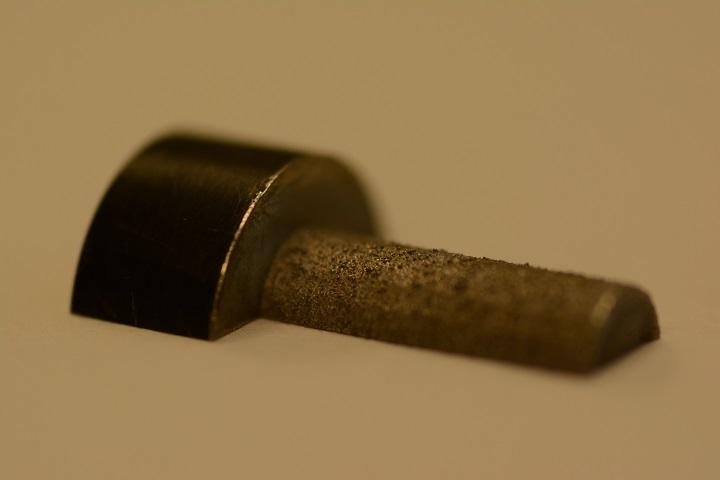A Recipe for Additive Manufacturing Success: GE Additive Materials Lab Tells Us What They Have Cooking
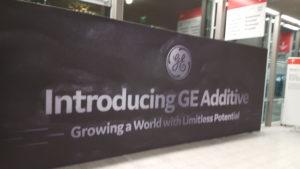
GE Additive’s introduction welcomed visitors to formnext 2016 [Photo: Sarah Goehrke for 3DPrint.com]
Key to the success of any AM endeavor is the quality of the materials in use. The best machinery can be rendered irrelevant if the materials input are not up to par, particularly where metal manufacturing is concerned. At the Additive Materials Lab at GE Global Research in Niskayuna, New York, a dedicated team are hard at work to ensure the development of not only the best materials, but the best processes to produce them. Built on concepts pioneered in the pharmaceutical industry, the Additive Materials Lab is working to study and understand combinations of materials and processes to optimize results for a broad variety of applications.
“In our work,” says Additive Materials Lab materials scientist Laura Dial, “we must understand the performance and durability of metal parts in complex systems like jet engines, where factors like strength, heat tolerance and crack resistance are extremely important.”
 As GE becomes ever more deeply entrenched in AM activity, the company is laying their intentions on the table: they are striving to be the best. The best possible in AM is a futuristic concept, in which “I need a precise component” can conceivably translate as easily as “Tea. Earl grey. Hot.” or to the future as seen by The Jetsons, in which production can be as simple as the push of a button. To that end, GE is working toward the creation of the Additive Materials Cookbook, a gathered ‘recipe book’ of combinations of materials that will serve best not for a dinner party but for high-performance, precision components with complex geometry. This isn’t your mother’s Jell-o mold; it’s a collection of ingredients that can be put toward almost any use imaginable.
As GE becomes ever more deeply entrenched in AM activity, the company is laying their intentions on the table: they are striving to be the best. The best possible in AM is a futuristic concept, in which “I need a precise component” can conceivably translate as easily as “Tea. Earl grey. Hot.” or to the future as seen by The Jetsons, in which production can be as simple as the push of a button. To that end, GE is working toward the creation of the Additive Materials Cookbook, a gathered ‘recipe book’ of combinations of materials that will serve best not for a dinner party but for high-performance, precision components with complex geometry. This isn’t your mother’s Jell-o mold; it’s a collection of ingredients that can be put toward almost any use imaginable.
Joe Vinciquerra, Manager of the Additive Materials Lab, took the time to tell 3DPrint.com about some of the work being done at the facility as I had A Few Questions For him to find out more about the operations at hand as well as the outlook toward what might soon be possible.
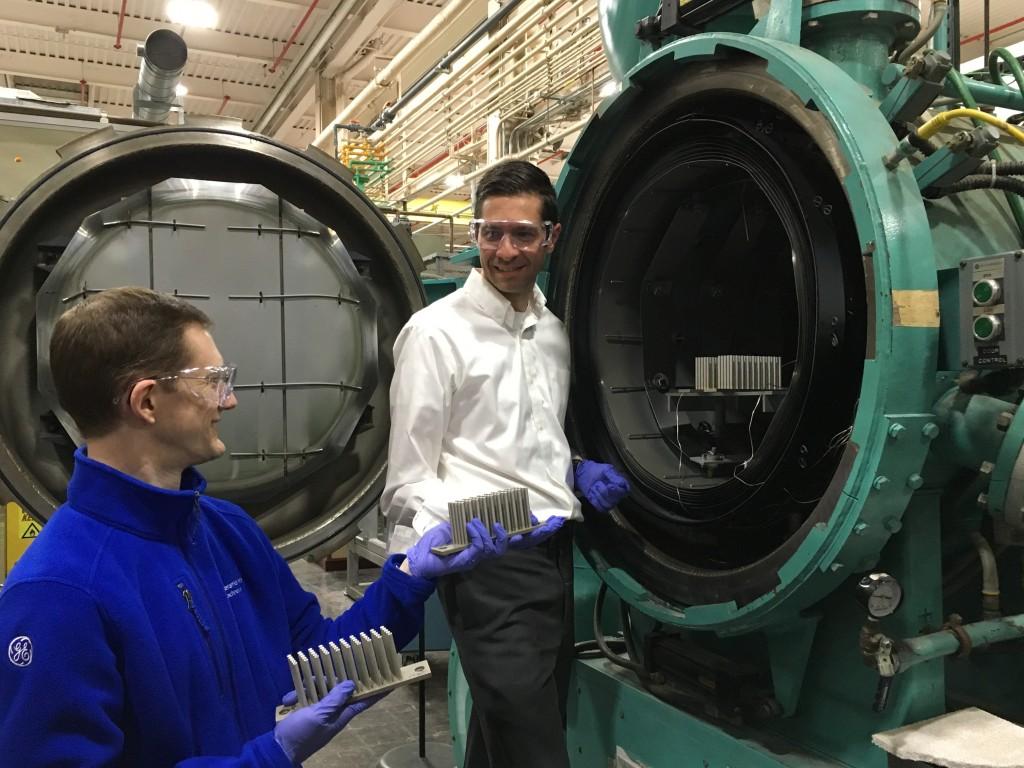
Vinciquerra (right) and Andy Deal, a metallurgist in the Additive Materials Lab, load sets of sample 3D printed metal parts in a vacuum oven for post-processing at GE Global Research. [Image: GE Global Research.]
Vinciquerra’s responses provide us with direct insight into the heart of the work going on in the Additive Materials Lab — and the more than 800 combinations of materials and process they are examining.
When was the Additive Materials Lab launched? How big is the team working here?
“GE has been developing additive materials for more than 8 years and formally launched the lab in the early part of 2016. In the lab, we have more than 20 team members focused exclusively on the materials and processing aspects of additive. Signature to GE Global Research, this team interacts with dozens of other scientists and engineers in different disciplines from around the campus to work on this technology.”
Can you tell us about some of the 800+ material/manufacturing process combinations being worked on? Have any been a surprise in terms of performing notably either better or worse than anticipated?
What types of manufacturing process variables are being studied?“The specific process combinations are proprietary. The novelty of what we’re doing is the scale of parallelism with the iteration process. We anticipate the ability to reduce the time it takes for process optimization of new materials by upwards of 5x. In terms of surprises, all we can say is that additive is a unique processing modality that affords both challenges and opportunities with materials like never before!”
“We estimate the number of process variables in a typical additive build to be in the hundreds. The art in what we are doing right now is rapidly screening those variables with carefully designed material compositions to hone in specific material characteristics, such as strength, durability, heat- and crack-resistance.”
How does this ‘recipe book’ approach benefit from the combinational chemistry approach begun in pharmaceutical research?
“The benefit to ‘combi-chem,’ as it is sometimes called, is the massive amount of ‘pass/fail’ data one can attain from a very small set of experiments. While material scientists have employed combi-chem-like approaches to materials development before, it is the additive manufacturing process itself that enables us to move through these large-scale screening experiments in record time. We’re talking tens to thousands of pass/fail data points from a single 3D build. Quickly understanding which pairs of processing parameters and material chemistries work, and which ones do not, is the same premise as understanding which chemical compounds work in the field of drug discovery.”
How have the formation of GE Additive and the acquisitions of Concept Laser and Arcam shaped the work happening in the Additive Materials Lab?
Have any successful material/process combinations from the lab been implemented in projects outside the R&D environment so far?“The acquisitions and launch of the new Additive business have greatly added to the amount of research we are doing and to the importance of our Lab’s activities. The discovery and application of new materials will greatly expand additive’s use not only in GE’s products but also for products outside GE’s traditional industry spaces. The Jetsons analogy is telling. The idea is being able to make parts for anyone, anywhere, anytime. But it requires much more than being able to make any design. It requires you to have the greatest variety, or recipe book in materials to choose from.”
“Up to this point, we have relied upon relatively traditional methods for developing materials for additive. To date, and with our colleagues from across the company, many of the traditional engineering materials we use in our products have been, or are in the process of being, translated for use in additive. This work comprises the early chapters of our recipe book. We’re just getting started with the combi-chem approach, and this year we will not only demonstrate the speed gains in material development by applying it to a traditional engineering alloy, we will also be applying it toward the development of an entirely new additive alloy system for use in our next-gen GE products.”
What can we expect to see from the Additive Materials Lab in 2017? Over the next five years? Ten?
“We talk often about having a so-called ‘recipe book’ for additive materials, but our product won’t be a literal book. Instead, we envision it as part of the digital brain for GE Additive machines; one that helps incorporate GE’s deep expertise in materials and one that is capable of continuously learning. Always getting better, and always adding value for our customers. So, some day, when you go to print a part, it could be a lot like a soda machine at a fast food restaurant where you can choose from several sub-flavors of cola such as vanilla, cherry, raspberry and so on.”
How big can we expect the AM materials ‘cookbook’ to be?
“We’re aiming high. Let’s just say we never want to be in the position of disappointing a designer by saying ‘brilliant design, but we don’t have a material that meets those specifications.’ So you can imagine quite a large book. Fortunately, all of the contents of this book will be in digital form!”
As process optimization is enhanced at incredible factors, the work coming from the Additive Materials Lab is sure to set GE more firmly on its way toward success in meeting the needs of customers and applications at unprecedented quality and volume. Important to the work done in additive manufacturing is the quality of repeatability, and by carefully documenting the work done in the ‘cookbook’ future work can benefit from the success found in materials recipes — leaving room to be built upon (layer by layer?) for additional iterations and applications. Discuss in the GE Additive Materials forum at 3DPB.com.
Subscribe to Our Email Newsletter
Stay up-to-date on all the latest news from the 3D printing industry and receive information and offers from third party vendors.
You May Also Like
Another Blow to the 3D Printing Sector: Layoffs at Essentium
Texas-based firm Essentium faces a new round of layoffs, reflecting the latest in a series of staff reductions throughout the 3D printing industry. According to an anonymous source, the company...
GE to Invest Nearly $500M in US Manufacturing, Including 3D Printing
In the latest signal that the pillars of US industrial output are serious about building on last year’s growing momentum to reshore the nation’s manufacturing, GE announced that it plans...
When 3D Printing Mergers Collapse: Essentium SPAC Fallout with Collider
Before investors pulled the rug out from mergers with special purpose acquisition companies (SPACs), 2021 was a record-breaking year as 604 blank-check deals raised $144 billion. The timing was crucial...
Essentium CEO Discusses High Speed 3D Printing’s Rapid Rise at RAPID+TCT 2021
Essentium, Inc. is one of the fastest developing startups in the fused filament fabrication (FFF) space, in that it is quickly rolling out advanced technology while also growing beyond the...


